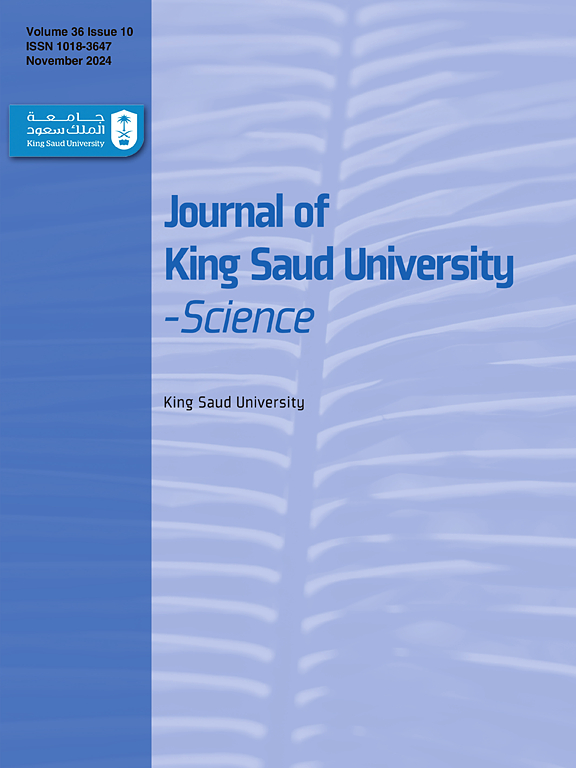Modulatory effects of glutamic acid on growth, photosynthetic pigments, and stress responses in olive plants subjected to cadmium stress
IF 3.6
3区 综合性期刊
Q1 MULTIDISCIPLINARY SCIENCES
引用次数: 0
Abstract
Cadmium (Cd) is a toxic heavy metal that severely impacts plant growth and photosynthesis and induces oxidative stress. This study investigates the modulatory effects of glutamic acid (GA) on Olea europaea (olive) seedlings subjected to cadmium stress. The experiment included control, Cd-stressed, GA-treated, and combined Cd and GA-treated groups. Cd exposure significantly reduced plant growth, as evidenced by decreased root length (3.5 cm) and shoot length (9 cm) compared to control plants (5 cm and 12 cm, respectively). Additionally, Cd stress led to a reduction in chlorophyll content (16.2 mg/g fresh weight) and elevated oxidative markers like H2O2 and MDA. The application of GA significantly improved plant growth and physiological parameters, with statistically significant increases in root length (up to 6.5 cm) and shoot length (up to 14 cm) in the combined treatment group (p ≤ 0.05). Furthermore, GA treatment led to a marked elevation in total chlorophyll content (up to 27.5 mg/g fresh weight), compared to 16.2 mg/g in Cd-stressed plants (p ≤ 0.05), reflecting a significant improvement in photosynthetic efficiency. GA also elevated the antioxidant enzyme activity catalase (CAT) and peroxidase (POD), reducing oxidative stress by decreasing hydrogen peroxide and MDA levels. The findings suggest that glutamic acid effectively mitigates Cd-induced phytotoxicity, enhancing stress resistance and promoting plant growth. This research provides valuable insights into using glutamic acid as a possible approach to mitigate heavy metal stress in plants, offering implications for agriculture and environmental management in Cd-contaminated areas. Specific applications may include its use in phytoremediation practices or as a supplement in agricultural management to improve crop resilience in polluted environments. Further research could explore the molecular mechanisms underlying GA’s protective effects and its potential synergy with other biostimulants to enhance heavy metal tolerance in a broader range of crops.
谷氨酸对镉胁迫下橄榄植物的生长、光合色素和胁迫反应的调节作用
镉(Cd)是一种有毒重金属,严重影响植物的生长和光合作用,并诱发氧化应激。本研究调查了谷氨酸(GA)对受到镉胁迫的油橄榄幼苗的调节作用。实验包括对照组、镉胁迫组、谷氨酸处理组以及镉和谷氨酸联合处理组。与对照组(根长和芽长分别为 5 厘米和 12 厘米)相比,镉胁迫明显降低了植物的生长,表现为根长(3.5 厘米)和芽长(9 厘米)的减少。此外,镉胁迫还导致叶绿素含量降低(16.2 毫克/克鲜重)以及 H2O2 和 MDA 等氧化标记物升高。施用 GA 能明显改善植物的生长和生理参数,在联合处理组中,根长(最长 6.5 厘米)和芽长(最长 14 厘米)的增加具有统计学意义(p ≤ 0.05)。此外,与镉胁迫植物的叶绿素含量(16.2 毫克/克鲜重)相比,GA 处理使叶绿素总含量明显提高(高达 27.5 毫克/克鲜重)(p ≤ 0.05),这反映出光合效率有了显著提高。GA 还能提高抗氧化酶活性过氧化氢酶(CAT)和过氧化物酶(POD),通过降低过氧化氢和 MDA 水平来减轻氧化应激。研究结果表明,谷氨酸能有效减轻镉诱导的植物毒性,增强抗逆性,促进植物生长。这项研究为利用谷氨酸缓解植物的重金属胁迫提供了宝贵的见解,对镉污染地区的农业和环境管理具有重要意义。具体应用可能包括在植物修复实践中使用谷氨酸,或将其作为农业管理的补充,以提高作物在污染环境中的恢复能力。进一步的研究可以探索 GA 保护作用的分子机制及其与其他生物刺激剂的潜在协同作用,以提高更多作物对重金属的耐受性。
本文章由计算机程序翻译,如有差异,请以英文原文为准。
求助全文
约1分钟内获得全文
求助全文
来源期刊

Journal of King Saud University - Science
Multidisciplinary-Multidisciplinary
CiteScore
7.20
自引率
2.60%
发文量
642
审稿时长
49 days
期刊介绍:
Journal of King Saud University – Science is an official refereed publication of King Saud University and the publishing services is provided by Elsevier. It publishes peer-reviewed research articles in the fields of physics, astronomy, mathematics, statistics, chemistry, biochemistry, earth sciences, life and environmental sciences on the basis of scientific originality and interdisciplinary interest. It is devoted primarily to research papers but short communications, reviews and book reviews are also included. The editorial board and associated editors, composed of prominent scientists from around the world, are representative of the disciplines covered by the journal.
 求助内容:
求助内容: 应助结果提醒方式:
应助结果提醒方式:


